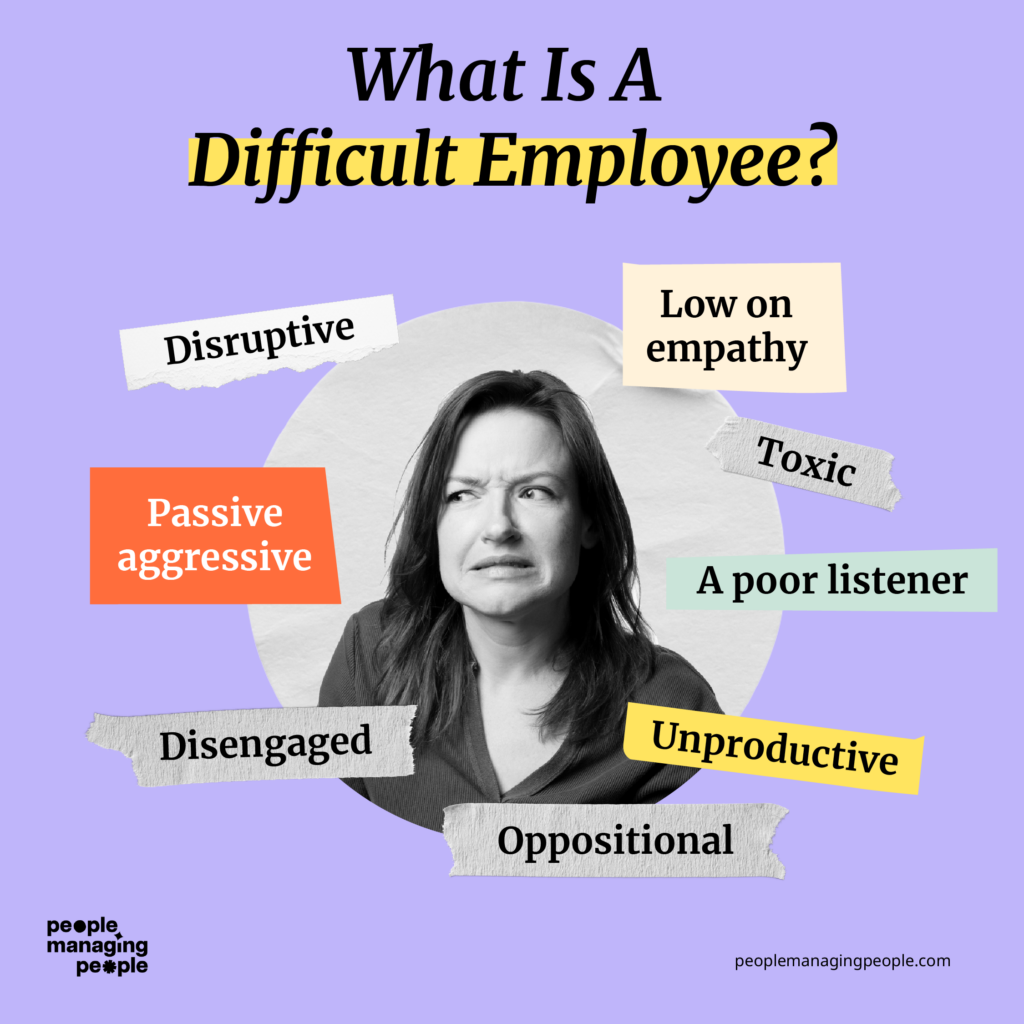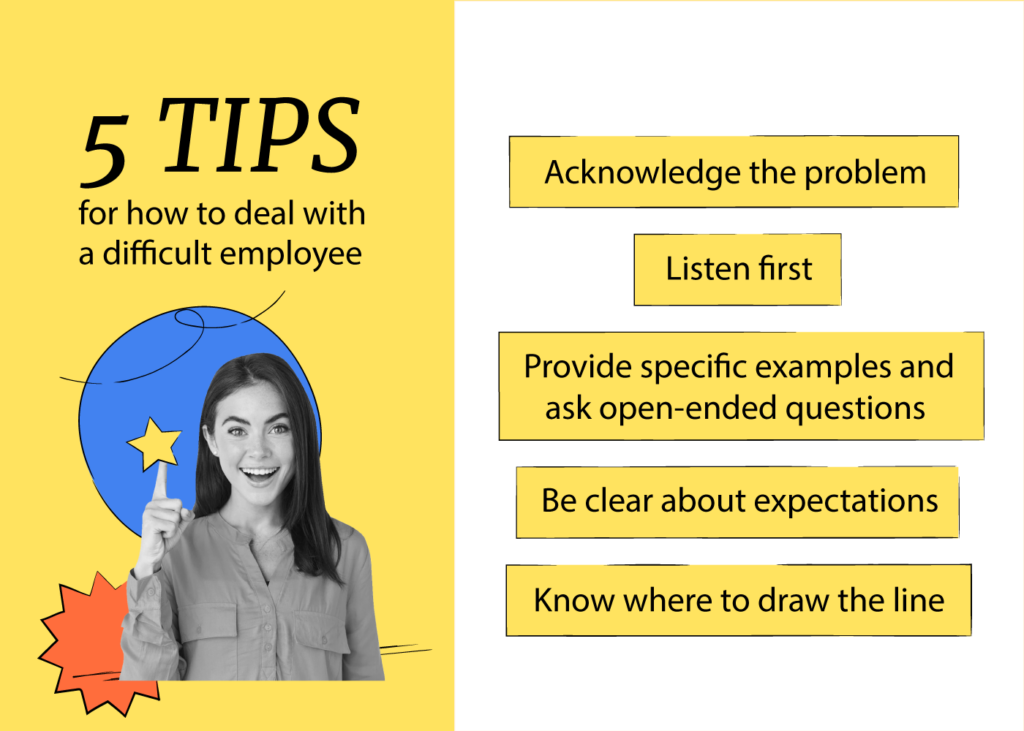We’ve all had them.
The difficult employees. The teammates that drive you nuts. The ones that make your heart sink every time you have to deal with them.
In my own personal Hall of Difficult Colleagues, I remember Compulsive Liar, the Patronizing Winker, the Drama Queen, and the Obstructive Jobsworth, to name a few.
And of course, there’s a good chance they remember me as a difficult colleague too!
However, things become trickier once you become a manager. Now it’s your role to help every team member reach their potential, collaborate effectively, and communicate successfully. Instead of simply labeling a team member as difficult, you’re responsible for helping them become part of the team.
You may find yourself doubting whether you can turn their behavior around and help them become a top performer. Will you just have to resign yourself to fixing the problems they create?
If you’ve ever found yourself at loss for how to deal with a difficult employee, you’ve come to the right place. In this article, we’ll look at what makes some people difficult to work with, and give you some actionable tips if you find a tricky individual on your team.
What is a difficult employee?
There are many traits that could make someone hard to work with. For example, they might be:

- Disruptive
- Oppositional
- Disengaged
- Toxic
- Unproductive
- Passive aggressive
- A poor listener
- Low on empathy
Or perhaps they just don’t like you!
However, it’s worth bearing in mind that difficulty, like beauty, is in the eye of the beholder.
Dr. Louise Hamilton, a counseling psychologist, advises managers to “take a moment to reflect and wonder why someone might bother you so much.” Do they remind you of someone else? Are there particular behaviors that you find triggering?
Similarly, if the employee is causing friction with other team members, there may be more going on than meets the eye.
Perhaps the employee is not the issue, but rather what they represent. For instance, is the “difficult” employee a new hire who has taken on a role that someone else was expecting to get? Were they recommended by an unpopular manager from another department? Is the team dynamic at fault, instead of the individual in question?
Executive coach Greg Stephens observes: “I find all coworkers can be “tricky” at times. It depends on the person, the kind of day they’re having, the circumstances surrounding the issue being discussed, and the relationship at that moment.”
So, even if you decide that the employee themselves is the cause of the problem, it’s still worth doing a little digging. After all, as Edoardo Binda Zane, a communication trainer and leadership coach, points out:
“The thing to remember is that “difficult” is always subjective. To deal with a difficult colleague effectively, the first thing to do is always to understand what the driver of their behavior is.”
In sum, if there’s a difficult employee on your team, don’t immediately leap to conclusions without all the facts. Here’s what to do instead:
5 tips for how to deal with a difficult employee

When it comes to managing an employee with a bad attitude, here are 5 actionable steps to address the issue while remaining professional:
1. Acknowledge the problem
It can be tempting to avoid confronting the problem. After all, few of us enjoy difficult conversations.
However, this is short-sighted thinking. Executive coach Robin Pou points out, “Confrontation and conflict are two different things. If you confront an issue, it’s possible it can be resolved—thus heading off conflict. However, if you do not confront an issue you are almost certainly assured of a future conflict… Confronting issues is hard and it takes time. But, conflict is harder and more time consuming.”
Stephens explains that, in his experience, the issue is not that managers don’t want to confront a challenging employee—it’s that they don’t know how.
“It seems like a lack of will, but it’s actually a lack of skill.” Many managers worry that they won’t be able to effectively address the problematic behavior. If you don’t feel comfortable having difficult conversations, then it might be worth reaching out to the human resources department to request relevant learning resources.
2. Listen first
Once you’ve decided to take action, you may feel tempted to sit the employee down and outline the impact of their bad behavior. However, Binda Zane warns that this could backfire. Instead, he’s found that listening before you speak or act is far more effective when dealing with difficult people:
“The most difficult colleague I ever had was someone who would not carry out his assigned tasks. When confronted, he would simply apologize, promise he’d carry them out, and simply never do them. It went on and on. It was frustrating, and it delayed everyone’s work.
I tried everything from ignoring him (which didn't work), to confronting him (which didn't work), and even talking to our manager about it (which also didn’t work). The only thing that did work was the most difficult thing to do: I listened to him.
The thing is, most of the time, people just want someone to hear them out. Even that simple act of listening to their deeper motives can make them feel understood and motivate them to do something about their behavior. It’s basic reciprocity: if you listen to me, I’ll listen to you.”
By listening actively, with empathy rather than judgment and advice, you position yourself as a source of support rather than criticism. After all, you and your direct report both want the same thing—a positive and productive working environment for the whole team.
3. Provide specific examples and ask open-ended questions
When it comes to discussing the employee’s behavior, stick to facts and observations, rather than opinions.
For example, “I noticed in the last meeting that you interrupted other team members repeatedly.” This will help keep the conversation professional and objective, rather than descending into debate and argument.
In a similar vein, don’t ask leading questions—they can cause your problem employee to become defensive. Try to keep things open-ended and invite discussion. For instance, instead of saying “Why do you always interrupt everyone? Do you not find their input valuable?”, try rephrasing it as “How do you feel during team meetings?” or “What do you think is going on?”
4. Be clear about expectations
Management consultant Liz Kislik cautions managers to be explicit about the negative impact caused by an employee’s behavior.
In an article in HBR, Kislik recalls a manager who was reluctant to speak with a direct report about her poor performance because he was worried about hurting her feelings. However, without the feedback she needed, the employee’s performance continued to decline, and in the end she was demoted.
In other words, by failing to be clear about his expectations, the manager denied the underperforming employee the chance to improve her results. Every employee, no matter how challenging, deserves the opportunity to learn and develop.
With HR case management platforms, managers can track behavioral trends and implement personalized solutions for challenging employees.
5. Know where to draw the line
That said, managers must also be prepared to make tough decisions.
To quote Natasha Maddock, from Events Made Simple: “Dealing with difficult employees is probably one of the toughest tasks a manager will face. However, if you fail to deal with a disruptive team member quickly and effectively, the implications for the rest of your team can be catastrophic. Unfortunately, one bad apple can spoil the bunch and one negative individual can have significant influence on a work environment, creating a toxic atmosphere that impacts performance and engagement for an entire department. So better to take action swiftly if you can!”
Once you’ve given the employee feedback, and provided ample opportunities and a reasonable time frame to improve their negative behavior, it’s time to consider further steps. You may wish to proceed to disciplinary action, or even dismiss the employee. It’s never easy to handle difficult employees but, as a manager, you have to consider the good of the team as a whole. One toxic employee can damage not only the morale of the team, but the company culture as a whole.
To deal with difficult employees, look for the root cause.
If you’re struggling to handle a challenging direct report, the key is to find out what the real issue is.
Is the employee really that difficult, or are they suffering from personal problems? Do they have a bad attitude because they feel passed over for promotion, or because they feel isolated from the rest of the team?
Or perhaps they aren’t the problem at all. Maybe your own history or personal trigger points make them difficult for you to work with, or perhaps the team dynamics are creating an overly confrontational environment.
No matter what the issue is, as a good manager, it’s your job to address it as soon as possible. Be honest and direct, and approach your conversations with the problematic employee in good faith and with plenty of empathy. There’s every chance you can turn the situation around, and help your difficult employee become a happy and productive member of the team.
If you’re a new manager looking for more advice from expert business leaders on how to manage people, look no further than our New Manager Handbook. You’ll find expert interviews and best practice tips and tricks to help you get off to the best possible start.
Some further articles to help you along your leadership journey:
- Why You Shouldn’t Be Afraid To Ask For Help As A New Manager (and How to Do It)
- From Friend To Boss: How To Establish Authority & Set Boundaries As A New Manager
- In Too Deep: How To Keep Calm & Carry On When You’re Overwhelmed As A New Manager
- People Management Tips For New And Experienced Managers
- 5 Ways To Give More Effective Feedback
- How To Go From Manager To Coach
For regular expert advice on how to lead teams and build healthy, productive organizations, subscribe to the People Managing People newsletter.




